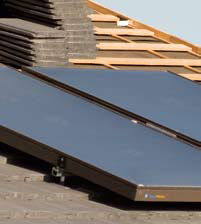At 609 Sunridge Crescent on the outer edge of West Lethbridge, construction and science have allied to build a  1,300-square-foot laboratory known as The Living Home.
1,300-square-foot laboratory known as The Living Home.
When the exterior was completed recently, neighbours likely noticed a few oddities, distinctive features that set it apart from their own domiciles.
First of all, no one lives at 609. Once spring arrives, plants will begin sprouting on the second-storey deck. The roofing tiles are concrete, and there are solar panels up there, too. A closer look will reveal small plastic tubes protruding slightly from the outer walls, making the home seem like a patient waiting to be connected to a bank of monitors.
The frequent comings and goings of an odd assortment of people need not concern the neighbourhood, however. The yard will be tended, the walks shoveled and loud parties kept to the one at the grand opening of the project. But by then, there will be reason to celebrate.
The Living Home, built by Cedar Ridge Homes from concepts developed at Lethbridge College on a lot supplied by the City of Lethbridge, is a research project that could change the way homes are constructed by implementing the findings into environmental responsibility.
“We’ve built this with a different philosophy,” says Lonnie Hoy, owner of Cedar Ridge, who admits to being affected by Al Gore’s An Inconvenient Truth. “I think, as a small builder, we can influence the market and make a difference. We want to share the technological findings with others.”
First, a bit of truth. Not everything considered in the construction of the home was found to be the most sound, environmentally speaking. Research by Lethbridge College students and instructors Mark Bohnert and Braum Barber discovered not all products advertised as “green” actually live up to the claims. The house will remain empty for a year while it is prodded and probed (those small tubes really do hook up to wind-pressure monitors), measured and gauged in 13 experiments to gain every drop of knowledge. That knowledge will be shared in real time on the project’s website.
Project outcomes include the validation and application of alternative materials and technologies within an integrated home design, as well as enhancing of the efficiency and productivity of construction practices for residential home building. The goal is to raise interest in a home design that considers construction processes, the application of new technologies, and healthy, low-impact living opportunities as they apply to local conditions.
All of the parties involved hope that by sharing the learning, some of the misconceptions surrounding the “building green” phenomenon will be explained.
The project is a goldmine of student involvement and learning. Students in Engineering Design and Drafting Technology pored over details on materials to determine their suitability and value in green design. Interior Design students chose flooring, paints and fabrics that advance the structure’s environmental standards. Multimedia Production students created the website and decided how to best satisfy the public’s interest for the type of knowledge gleaned.
To some, a “green” home might be one covered in solar panels with a wind turbine in the back yard and a metre of insulation in the walls. None of these fully advance the concept of environmental responsibility.
Let’s check out the features that do:
- a reduced footprint through smarter design and efficient use of space.
- a rooftop deck with eight inches of soil for growing native species in an interpretive garden.
- photo-voltaic tiles, which can produce 2 kW, enough to power about a quarter of an average Albertan’s electricity demand.
- two solar panels to provide hot water heating. No energy will be required to produce hot water in the summer; natural gas, half of what a normal home would require, will be used in the winter, an overall reduction of 40 per cent.
- bamboo cabinets. Bamboo can be harvested every year after seven years, compared to decades for trees, and can yield 20 times more timber than trees on the same area.
- Canadian maple flooring finished in linseed oil to minimize off-gassing in the home’s early years.
- insulated concrete forms and foam insulation to cut heating costs and eliminate air-conditioning.
- a power system that will, for the first time in Lethbridge, sell energy back to the electrical grid.
- a coiled water input that warms water as it enters the house using the heat from waste water, thus reducing water-heater use.
- an alcohol-burning fireplace requiring no flue.
- an air-to-air heat exchanger to keep the air in the home healthy and fresh, and reduce the energy needed to heat fresh air in the winter. Air in the home is replenished every 30 minutes.
- maximized light from windows.
- fibreglass-enclosed windows.
- contained rainwater runoff.
- low-flow faucets and fixtures.
“We are collecting unbiased results”, says Barber. “These are results based on research done in Lethbridge, not Arizona. It’s nice to have a made-in-Lethbridge solution. Every aspect we discover will be shared with the public, who then have something concrete on which to base their building decisions.”
Sense and sensibility pervade here. The project team decided against a system to recycle sink and tub water to flush toilets; the price would have been prohibitive and wasteful in a city with a cutting-edge wastewater treatment plant.
“The ‘sticking-it-to-the-man’ appeal of alternative technologies isn’t always worth it,” says Barber. “Sometimes it’s better just to turn off a few lights.”
Asphalt and vinyl products, which require considerable energy to produce, result in harmful emissions, and often end up as landfill in a relatively short time, were rejected. The roof is covered in concrete tiles, which, while three times the cost of asphalt shingles, will last five times as long. When they do finally have to be replaced about 50 to 75 years from now, they can be crushed and used elsewhere, rather than being trucked to the dump.
The project team could have spent a “braumillion” dollars (that’s a lot) building The Living Home, but the return wouldn’t have made financial sense. Instead, it stuck to its construction budget of $360,000. In the end, the home cost 10 to 15 per cent more than a normal home of the same size, and will be cost neutral after 60 years.
“We didn’t reinvent the wheel,” says Hoy. “The home is still built out of wood and concrete. But we used new concepts to match changing perceptions. There are a lot of gimmicks people try to sell you that don’t measure up. In the end, it comes down to living a responsible lifestyle. You can’t just throw technology at the problem.”


